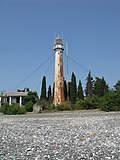Background
During the time of the Soviet Union, Abkhazia's Black Sea beaches attracted tourists from a number of surrounding countries, constituting a 40 percent share of the Georgian Soviet Socialist Republic's tourism market. Prior to the 1992-93 war in Abkhazia, over 202,000 tourists visited the region every year. [4] Abkhazia is now a disputed region, with Russia, Nicaragua, Venezuela and Nauru as the only United Nations member states that recognise the territory as an independent nation.[ citation needed ]
Despite the risks involved, about one million tourists visit Abkhazia each year, mainly from Russia. [5] One of the attractions of visiting Abkhazia as opposed to other Black Sea coastal towns, such as Sochi, is the lower cost of visiting the breakaway state. [6] One night's accommodation in Gagra, for example, cost US$25 in 2003, with the cheapest hotel in the region setting a rate of US$12 for a room and meals in that year. A trainride from a Russian border town of Sochi to the Abkhazian capital of Sukhumi only cost US$1 in 2003. However, Abkhazia's tourism facilities are below Western standards, with much of its infrastructure dating back to the Soviet era. [4]











